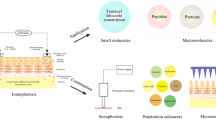Abstract
Classic methods of drug delivery have embraced a number of routes into the site of pharmacological action. Modern preference, wherever possible, is for a non-invasive route to minimise the chance of cross infection, especially of the AIDS virus. The skin, which is the largest organ in the human body, is a particularly appealing route as, in the absence of wounds and blemishes, it offers a natural, high-integrity, barrier to the outside world. Skin patches containing active drug that is allowed to diffuse passively across the external skin barrier into the bloodstream now enjoy wide application but a problem is that the rate of egress is often slow.
For certain ionic drugs, including local anaesthetics and, more recently, peptides and gene-based, biotechnological engineered pharmaceuticals, it is possible substantially to enhance transdermal transport by iontophoresis. The technique of iontophoresis facilitates the passage of ionic drugs through the skin using an electric current. Ionically conducting polymers (polymer electrolytes) are potential candidates as hosts for drugs to be delivered iontophoretically.
Key issues affecting iontophoretic delivery are reviewed in this paper and the potential role of polymer electrolyte materials in iontophoretic devices will be described.
Similar content being viewed by others
References
A.K. Banga, Electrically Assisted Transdermal and Topical Drug Delivery, Taylor and Francis, London, 1998 (ISBN 0-7484-0687-5).
P. Tyle and P. Agrawala, Pharm Res.6, 355 (1989).
A.L. Watkins, A Manual of Electrotherapy, 3rd Ed., Lea & Gebiger, USA, 1968.
A. Helmstadter, Pharmazie56, 583 (2001).
S. Leduc, Electric Ions and Their Use in Medicine”, Rebman, London, 1908
L.E. Gibson, and R.E. Cooke, Pediatrics23, 545 (1959).
M.B. Delgado-Carro and R.H. Guy, STP Pharma Sciences11, 403 (2001).
M.R. Prausnitz, V.G. Bose, R. Langar, and J.C. Weaver, Proc. Natl. Acad. Sci., USA90, 10504 (1993).
L.P. Gangarosa, N. Park, C.A. Wiggins and J.M. Hill, J. Pharm. Exp. Ther.212, 377 (1980).
K. Yokoyama, K. Matsumoto, and J. Murase, J. Clin. Laser Med. & Surgery18, 9 (2000).
N. Sekkat, A. Naik, Y. N. Kalia, P. Glikfeld and R.H. Guy, J. Controlled Release81, 83 (2002).
C. Curdy, Y.N. Kalia, F. Falson-Reig, and R.H. Guy, AAPS Pharm. Sci.2, art. no. 23. (2000).
R. Plutchik and H.R. Hirsch, Science141, 927 (1963).
D.F. Untereker, J.B. Phipps and G.A. Lattin, US Patent 5573503 (1996).
Y.W. Chien and A.K. Banga, US Patent 5250022 (1993).
S. Dinh, S.E. Wouters and J.R. Selafani, Pharm. Res.13, 360 (1996).
J.B. Phipps, US Patent 5403275 (1995).
W.T. Zempsky and M.A. Ashburn, Am. J. Anesthesiol.25, 158 (1998).
K.C. Sung, J.Y. Fang and O.Y. Hu, J. Controlled Release67, 1 (2000).
R. van der Geest, T. van Laar, J.M. Gubbens-Stibbe, H.E. Bodde and M. Danhof, Pharm. Res.14, 1804 (1997).
P.J. Sadler, H.M. Thompson, P. Maslowski and A. Liddle, Br. J. Anaesth.82, 432 (1999).
T.R. Bacro, E.B. Holladay, M.J. Stith and C.M. Smith, Cancer Detect. Prev.24, 610 (2000).
V. Preat and N. Dujardin, STP Pharma Sci.11, 57 (2001).
K. Karami, N. Merclin, F. Brouneus and P. Beronius, Int. J. Pharmaceutics201, 121 (2000).
R.G. Linford, Electrochemical Science and Technology of Polymers Volume 1 and Volume 2, Elsevier Applied Science, London, (1987) & (1990).
R.G. Linford, R.J. Latham, P.M. Taylor and T.S. Sahota: in European Symposium on Transdermal Administration, Editions de Sante, Paris (1997).
J.E.F. Reynolds, 9ed, Martindale, The Extra Pharmacopoeia (30th edition), The Pharmaceutical Press, London, (1993).
T.S. Sahota, R. J. Latham, R.G. Linford and P.M. Taylor, in: New Biomedical Materials (P.I. Haris and D. Chapman, Eds.) IOS Press, Amsterdam, (1998).
T.S. Sahota, R.J. Latham, R.G. Linford and P.M. Taylor, Drug Dev. Ind. Pharm.25, 307 (1999).
T.S. Sahota, R. J. Latham, R. G. Linford and P.M. Taylor, Drug Dev. Ind. Pharm.26, 1039 (2000).
L. Brannon-Peppas, http://www.devicelink.com/mpb/archive/97/11/003.html (1997).
Author information
Authors and Affiliations
Rights and permissions
About this article
Cite this article
Latham, R.J., Linford, R.G. & Schlindwein, W.S. Pharmaceutical and medical applications of polymer electrolytes. Ionics 9, 41–46 (2003). https://doi.org/10.1007/BF02376535
Received:
Accepted:
Issue Date:
DOI: https://doi.org/10.1007/BF02376535




